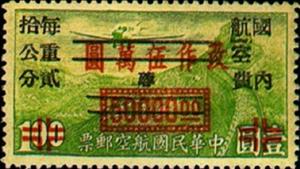Stamp: Junkers F13 over Nankou Pass with Great Wall (China - Provincial Issues- Szechuan (Sichuan) 1949)
Junkers F13 over Nankou Pass with Great Wall (China - Provincial Issues- Szechuan (Sichuan) 1949)
01 July (China - Provincial Issues- Szechuan (Sichuan) ) within release Plane over the Great Wall goes into circulation Stamp Junkers F13 over Nankou Pass with Great Wall face value None No Face Value
| Stamp Junkers F13 over Nankou Pass with Great Wall in catalogues | |
|---|---|
| Michel: | Mi: CN-IM-PSZ 41 |
| Stamp Number: | Sn: CN-IM-SZ C6 |
Stamp is square format.
Overprinted with "國內航空費每重貳拾公分" (from top to bottom, right to left, meaning 'Domestic air mail postage per 20 grams'), the letter "蓉" for Chengdu and strike bars over the previous surcharge.Also in the issue Plane over the Great Wall:
- Stamp - Douglas DC-4 over Sun Yat-sen Mausoleum face value None;
- Stamp - Junkers F13 over Nankou Pass with Great Wall face value None;
- Stamp - Junkers F13 over Nankou Pass with Great Wall face value None;
- Stamp - Junkers F13 over Nankou Pass with Great Wall face value None;
- Stamp - Junkers F13 over Nankou Pass with Great Wall face value None;
- Stamp - Junkers F13 over Nankou Pass with Great Wall face value None;
Stamp Junkers F13 over Nankou Pass with Great Wall it reflects the thematic directions:
An aircraft (pl. aircraft) is a vehicle that is able to fly by gaining support from the air. It counters the force of gravity by using either static lift or the dynamic lift of an airfoil, or, in a few cases, direct downward thrust from its engines. Common examples of aircraft include airplanes, rotorcraft (including helicopters), airships (including blimps), gliders, paramotors, and hot air balloons.Part 1 (Definitions and Abbreviations) of Subchapter A of Chapter I of Title 14 of the U. S. Code of Federal Regulations states that aircraft "means a device that is used or intended to be used for flight in the air."
Aviation is the practical aspect or art of aeronautics, being the design, development, production, operation and use of aircraft, especially heavier than air aircraft. The word aviation was coined by French writer and former naval officer Gabriel La Landelle in 1863, from the verb avier (synonymous flying), itself derived from the Latin word avis ("bird") and the suffix -ation.
A landscape is the visible features of an area of land, its landforms and how they integrate with natural or man-made features. A landscape includes the physical elements of geophysically defined landforms such as (ice-capped) mountains, hills, water bodies such as rivers, lakes, ponds and the sea, living elements of land cover including indigenous vegetation, human elements including different forms of land use, buildings and structures, and transitory elements such as lighting and weather conditions. Combining both their physical origins and the cultural overlay of human presence, often created over millennia, landscapes reflect a living synthesis of people and place that is vital to local and national identity. The character of a landscape helps define the self-image of the people who inhabit it and a sense of place that differentiates one region from other regions. It is the dynamic backdrop to people’s lives. Landscape can be as varied as farmland, a landscape park, or wilderness. The earth has a vast range of landscapes, including the icy landscapes of polar regions, mountainous landscapes, vast arid desert landscapes, islands and coastal landscapes, densely forested or wooded landscapes including past boreal forests and tropical rainforests, and agricultural landscapes of temperate and tropical regions.



